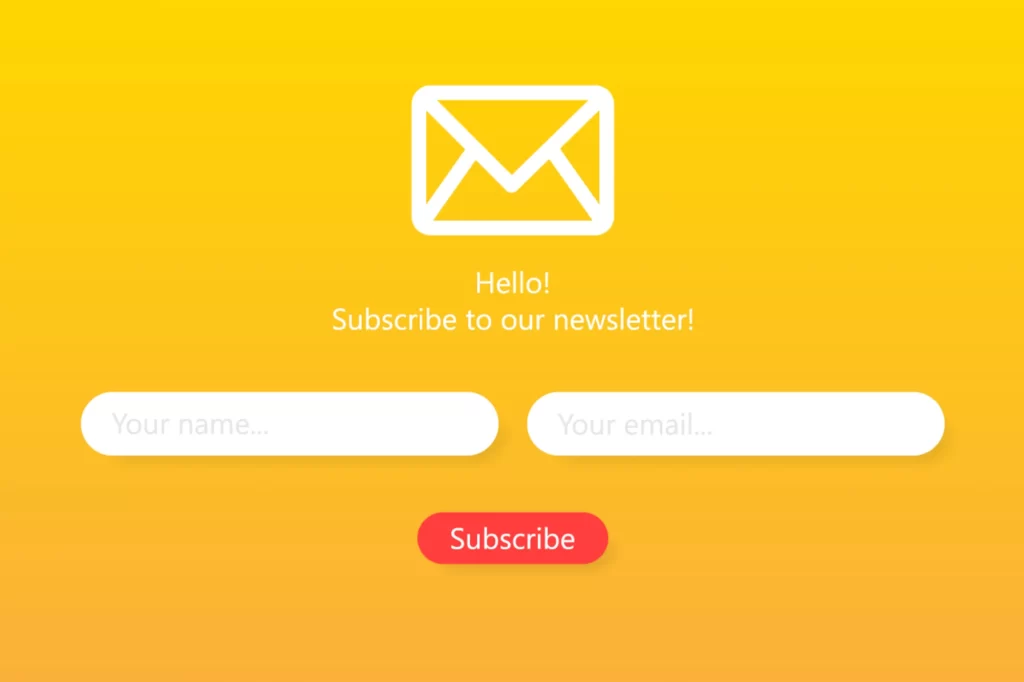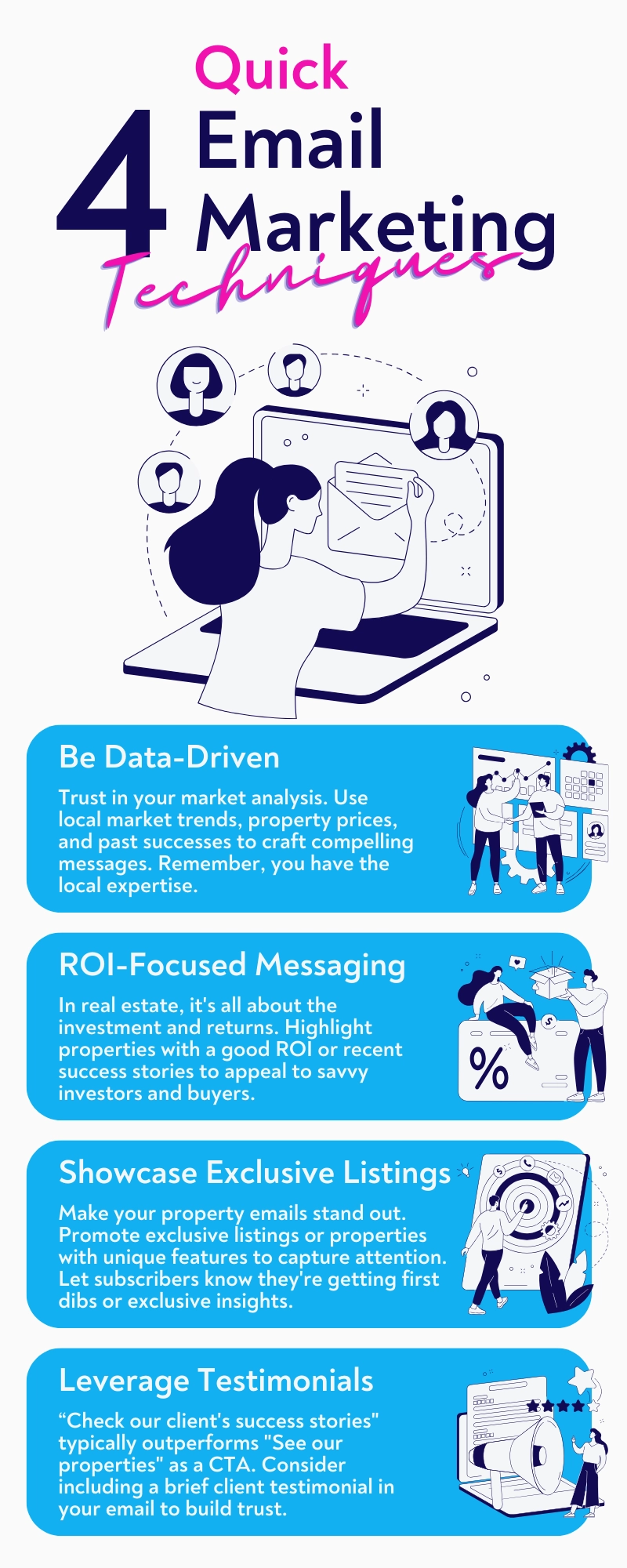Email might sound old school, like VHS tapes and slap bracelets, but it’s the OG digital communication tool for a reason. Consider this: For every $1 spent on email marketing, the average return is $42. It’s 40 times more effective at acquiring customers than Facebook or Twitter! But before you start crafting captivating email campaigns, you need a properly segmented email list. This ingenious strategy is not just about sending emails; it’s about sending the right emails to the right people at the right time.
Imagine being able to whisper into the ears of first-time homebuyers, luxury property seekers, and downsizing retirees, with messages that resonate with their deepest desires and needs. That’s email segmentation for you – powerful, precise, and promising! Get ready to infuse your email campaigns with a dose of enthusiasm, personality, and, most importantly, effectiveness.

1. Understanding Your Audience
Understanding your audience – it’s akin to being a detective in a mystery novel, except the clues are demographics and behaviors, and the prize is a thriving real estate business. To master the art of email segmentation, you first need to slip into the shoes of your audience and do a little jig. It’s not just about knowing they exist; it’s about understanding their dreams, desires, and what keeps them up at night (aside from that last cup of coffee!).
Research and Data Collection
- Demographics: Avoid discrimination based on age, gender, race, or other sensitive demographics. Instead, focus on what truly matters in real estate – preferences, needs, and behavior.
- Behavioral Data: This is where you become a digital Sherlock Holmes. Dive into how your audience interacts with your website and emails. Which listings make their hearts race? What content do they devour like their favorite novel? This data is gold, pure gold!
- Preferences: Straight from the horse’s mouth – ask your audience about their preferences. Surveys, feedback forms, casual chats at open houses – every bit helps. Do they dream of sprawling suburban homes or chic city apartments? Are they investing moguls or first-time timid buyers?
Crafting Buyer Personas
- Now, let’s get creative! Picture your typical clients – maybe it’s “First-time Homebuyer Emily” who’s juggling a new job and house hunting, or “Investor Steve” who’s looking for his next big score. Give these personas names, faces, backstories. When you write your emails, you’re not sending them into the void; you’re chatting with Emily and Steve. This personal touch is what transforms your emails from ‘just another newsletter’ to ‘can’t-miss updates from my favorite real estate guru’.
Visual: A series of buyer persona profiles, highlighting different client types. Ideal location within the buyer personas section.
Understanding your audience is not just a step in your marketing strategy; it’s the foundation upon which all successful campaigns are built. Equip yourself with this knowledge, and you’re not just a real estate agent anymore – you’re a marketing maestro, a whisperer of wants, a sage of segmentation. Ready to gather your audience insights?
2. Growing Your Email List

Welcome to the thrilling world of list-building, where every new email address is a potential key to a kingdom of opportunities! This is where your digital marketing journey takes an exciting turn. Growing your email list is not just about collecting contacts; it’s about building a community of engaged, interested prospects who are just a click away from becoming your next success story.
Website Opt-In Forms: Your Digital Nets
- Pop-up Forms: Think of these as friendly greeters at your digital storefront. A pop-up form offering a free e-book on real estate trends or market insights in exchange for an email address? That’s digital gold!
- Embedded Forms: These are the silent workers, subtly nestled in your blog posts or property listings. They’re the ‘P.S. Join our newsletter for more incredible insights’ at the end of your compelling content.
Social Media: The Modern Town Square
- Contests and Giveaways: Who doesn’t love a good contest? Use your social media platforms to run giveaways, offering something irresistible (like a consultation or a guide to local real estate) in exchange for email sign-ups.
- Teaser Posts: Share snippets of your wisdom, enticing your followers with a taste of your expertise, and then guide them towards your email list for the full meal.
Events and Open Houses: Your Physical Realm
- Sign-Up Sheets: Old school but gold. At every open house, have a sign-up sheet. Let your visitors know they can get exclusive property updates and real estate tips straight to their inbox.
Networking: The Art of Connection
- Real Estate Associations and Meetups: Your fellow agents and industry contacts are not just colleagues; they are gateways to new networks. Exchange business cards, make genuine connections, and invite them to join your email journey.
PRO TIP
Time pop-ups to appear after 30 seconds on your site, balancing visibility and user experience.
As you weave these strategies into your daily practice, remember, each email address is more than just a string of characters; it’s a door to a conversation, a connection, a potential client. With your email list growing, it’s time to dive into the heart of the matter: Segmenting this list like a pro.
3. Advanced Segmentation Techniques
Brace yourselves, marketing adventurers, for we are about to embark on a quest into the heart of email list segmentation. This is no mere shuffling of contacts; this is about crafting a tapestry of targeted communication that resonates with every unique individual in your growing audience.
Geographic Segmentation: Map Your Way to Success
- Location, Location, Location: This age-old real estate mantra holds true even in the digital realm. Segment your list based on areas of interest – “City Dwellers” or “Country Retreat Seekers” – and tailor your content to match their locale dreams.
Buyer Stage Segmentation: Timing is Everything
- First-time Buyers vs. Seasoned Investors: Each group requires a different conversation. One seeks guidance and reassurance, the other, savvy investment opportunities. Your emails should speak directly to where they are in their real estate journey.
Preference-Based Segmentation: A Personal Touch
- Property Types and Budget Ranges: Some dream of cozy cottages; others, of sprawling estates. Some have champagne tastes on a beer budget. Knowing these preferences allows you to send listings and advice that hit the mark every time.
Engagement Level: The Pulse of Your List
- Active Engagers vs. Silent Observers: Monitor who opens and clicks through your emails. The active ones might appreciate more frequent market updates or exclusive offers, while the quieter ones might need just a nudge with a monthly roundup or a compelling story.
With these advanced segmentation techniques, you transform from a mere sender of emails to a maestro of meaningful messaging. Each segment of your list becomes a special audience, awaiting your next captivating email tailored just for them.

4. Additional Segmentation Strategies
Alright, you’ve mastered the basics, but now it’s time to sprinkle a little extra magic on your segmentation strategies. These additional techniques are like adding secret ingredients to your marketing recipe, giving it that extra zing!
Specialized Segments: Catering to Unique Interests
- Luxury Home Aficionados vs. Cozy Cottage Lovers: Your list might contain a diverse range of property interests. Create segments for those enchanted by luxury estates and those charmed by quaint cottages, offering insights and listings that align with their dreams.
- Niche Properties Enthusiasts: Whether it’s historical homes, waterfront havens, or eco-friendly dwellings, tailoring content to these unique interests can make your emails the highlight of their day.
Life Stage and Circumstance: The Human Touch
- First-Time Sellers, Downsizers, Upgraders: Life is a journey, and so is homeownership. Segment your audience based on their life stage – first-time sellers needing guidance, empty nesters looking to downsize, or growing families seeking bigger spaces.
- Community Crusaders: Some clients are all about the community vibe. Segment these folks and share local events, volunteer opportunities, and neighborhood happenings.
Market-Specific Segments: Local Expertise
- Neighborhood Gurus: Segment your list by neighborhoods or regions. Become the go-to guru for specific areas, providing updates on market trends, recent sales, and hot new listings.
- Investor’s Corner: For the investment-minded, share insights on ROI, market fluctuations, and investment strategies.
With these additional segmentation strategies, you’re not just sending emails; you’re weaving stories, solving problems, and fulfilling dreams. Your email list is now a vibrant tapestry of varied interests and needs, each awaiting your next tailor-made message.
5. Crafting Tailored Content

Eureka! You’ve segmented your audience with the precision of a master jeweler. But what’s a gem without the right setting? Now, it’s time to craft content that sparkles with relevance and resonates with each unique segment of your list.
Speak Their Language: Personalized Messaging
- To the Luxury Seekers: Your emails should ooze sophistication and exclusivity, showcasing breathtaking properties with a narrative that transports them right into their dream home.
- For the Budget-Conscious: Empathize with their financial goals. Offer practical advice, affordable listings, and financial tips to turn their constraints into opportunities.
Storytelling: More than Just Listings
- Community Stories: Share heartwarming tales from the neighborhoods. Let them feel the spirit of the community, not just the bricks and mortar.
- Success Stories: Nothing inspires confidence like success. Share stories of happy clients who’ve found their dream homes or made a smart investment through your guidance.
The Power of Visuals: Show, Don’t Tell
- Stunning Imagery: Each email should be a visual feast – high-quality images of properties, happy clients, vibrant neighborhoods.
- Infographics and Market Data: Break down complex market data into digestible infographics that inform and impress.
Call to Action: Nudge Them Forward
- Clear and Compelling: Every email should have a purpose. Whether it’s to view a listing, read a blog post, or schedule a consultation, your call to action should be clear and irresistible.
PRO TIP
Use interactive elements like polls or quizzes in emails to increase engagement and gather more data about preferences.
Crafting content that speaks directly to each segment’s heart is not just about selling properties; it’s about building relationships, trust, and ultimately, a community of clients who see you as their go-to real estate expert.
6. Measuring Success and Adjusting Strategies
In the digital marketing odyssey, measuring success is your compass, guiding you through the seas of data towards the treasure of optimization. It’s not just about launching campaigns; it’s about learning, adapting, and evolving.
Key Performance Indicators (KPIs): Your Metrics of Mastery
- Open and Click-Through Rates: These are your bread and butter. High rates mean your content resonates; low rates signal a need for a tweak in your approach.
- Conversion Rates: How many of your email recipients are taking the desired action? This metric is the ultimate test of your email’s effectiveness.
Analytics: Your Secret Weapon
- Subscriber Growth: Track how your list is growing over time. A steady increase? Kudos! A plateau? Time to spice up your strategies.
- Engagement Over Time: Analyze when your audience is most responsive. Adjust your sending schedule to catch them in their most receptive moments.
The Art of the Pivot: Agile Adjustments
- Content Refresh: If certain emails underperform, don’t be afraid to revamp your content. Test different subject lines, layouts, and messaging.
- Segment Review: Regularly revisit your segments. People’s interests and circumstances change, and your segments should evolve with them.
Visual: A dashboard displaying various email campaign metrics, illustrating how to interpret and act on these insights. Ideal location at the end of the section.
Measuring and adjusting are not just tasks; they are integral parts of a dynamic email marketing strategy. They ensure that your campaigns are not just shots in the dark but are evolving conversations with your audience.
Divide and Conquer with Segmentation!
We’ve journeyed through the ins and outs of building and segmenting an email list that’s not just a list, but a vibrant community of prospects and future success stories. From understanding your audience to crafting content that sings to their hearts, from measuring your triumphs to dancing nimbly with your strategies – you’re now equipped to turn your email list into a wellspring of opportunities, a catalyst for growth and prosperity.
So keep refining, keep experimenting, and most importantly, keep connecting. Your email list is a living, breathing community, and with the right approach, it can be the cornerstone of your real estate success.
KEY TAKEAWAYS
- Understand your audience deeply for effective segmentation.
- Regularly update and refine your email list segments.
- Personalize content to resonate with each segment.
- Use analytics to measure success and make adjustments.
- Leverage technology for efficient segmentation and automation.
- Experiment with different content formats, including videos and webinars.
- Keep an eye on market trends and competitor strategies.
- Focus on building long-term relationships, not just transactions.
FAQ
How often should I update my email list segments?
Regularly review and update your segments every few months to ensure they align with current trends and audience shifts.
Can I automate the segmentation process using digital tools?
Absolutely! Many email marketing platforms offer automation features for segmentation based on subscriber behavior and preferences.
How do I handle unengaged subscribers on my email list?
Consider a re-engagement campaign or, as a last resort, removing them to maintain a healthy, active email list.
Is it effective to combine multiple segmentation strategies?
Combining strategies like geographic and behavioral segmentation can enhance personalization and effectiveness.
What’s the best way to ask for feedback for email content improvement?
Include a simple feedback form or survey link in your emails, encouraging recipients to share their thoughts and preferences.